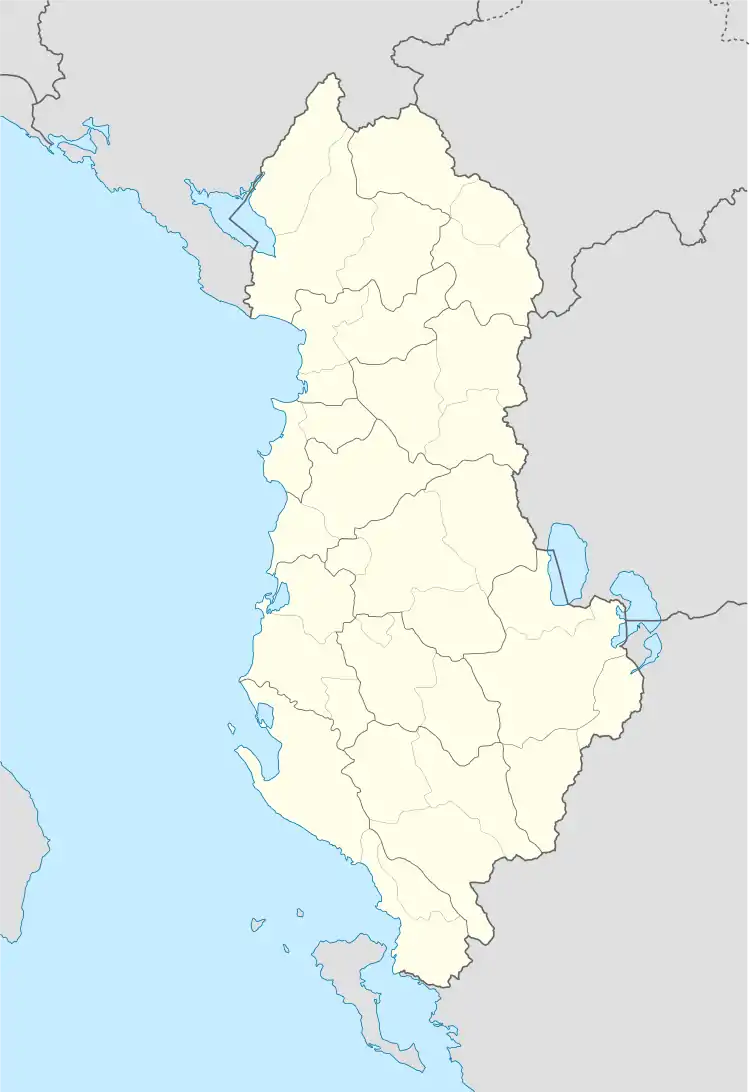Labova e Kryqit
Labovë e Kryqit (Labovë of the Cross) is a settlement in Southern Albania, which has taken the name of its famous church, the Dormition of the Theotokos Church. It consists of two neighbourhoods: Labovë e Poshtme (Lower Labovë) and Labovë e Sipërme (Upper Labovë).[1] To distinguish it from its neighbour Labovë e Madhe (Labovë e Vangjel Zhapës), the village is known by two names Labovë e Kryqit, in reference to a nearby old Byzantine church and Labovë e Libohovës (Labovë of Libohovë).[1] It is part of the Qendër Libohovë subdivision of the Libohovë municipality, in Gjirokastër County, southern Albania.[2]
Labovë e Kryqit | |
|---|---|
Settlement | |
 Labovë e Kryqit | |
| Coordinates: 40°4′25″N 20°17′30″E | |
| Country | |
| County | Gjirokastër |
| Municipality | Libohovë |
| Municipal unit | Qendër Libohovë |
| Time zone | UTC+1 (CET) |
| • Summer (DST) | UTC+2 (CEST) |
Demographics
The village of Labovë e Kryqit is one of mixed speech (Albanian and Greek) which is inhabited by an Orthodox Albanian population that speaks Albanian as a mother tongue.[3][4] The village is also inhabited by members of the Greek minority. Aromanians who form a significant community in the village.[3] The Aromanian presence in Labovë e Kryqit dates to the 20th century when during the communist era of Albania they settled in the village.[5]
Notable people
- Vasileios of Dryinoupolis metropolitan bishop and member of the provisional Government of Northern Epirus (1914).
References
- Pashkët në Labovë të Kryqit, Gazeta Shqip, 12 April 2015. "Një vend që për shkak të historisë mistike, të larmishme dhe të lavdishme, njihet me disa emra; Labovë e Poshtme dhe Labovë e Sipërme (emërtimi i dy pjesëve të të njëjtit vendbanim), Labovë e Kryqit (emërtim që lidhet me praninë e një kishe të vjetër bizantine dhe të një kryqi që tani është zhdukur dhe Labovë e Libohovës (për ta dalluar nga Labova e Vangjel Zhapës që ndodhet në Odrie në veri të Lunxhërisë."
- Law nr. 115/2014 Archived 2015-09-24 at the Wayback Machine
- Kallivretakis, Leonidas (1995). "Η ελληνική κοινότητα της Αλβανίας υπό το πρίσμα της ιστορικής γεωγραφίας και δημογραφίας [The Greek Community of Albania in terms of historical geography and demography." In Nikolakopoulos, Ilias, Kouloubis Theodoros A. & Thanos M. Veremis (eds). Ο Ελληνισμός της Αλβανίας [The Greeks of Albania]. University of Athens. p. 51. "ΑΧ Αλβανοί Ορθόδοξοι Χριστιανοί, Β Βλάχοι"; Αλβανοί Ορθόδοξοι Χριστιανοί"; p.56. "LABOVA E VOGEL ΛΑΜΠΟΒΟ ΜΙΚΡΟ/Ζαππαίο 246 ΑΧ + Β"
- Hammond, Nicholas Geoffrey Lemprière (1967). Epirus: the Geography, the Ancient Remains, the History and Topography of Epirus and Adjacent Areas. Oxford: Clarendon Press. p. 209. ISBN 9780198142539.
Whereas Libohovë and the villages north of it are Albanian in speech, those of the plateau form the most easterly pocket of Greek speech in North Epirus. Between Libohovë and the plateau the two hamlets of Labovë (115 houses) are of mixed speech, the mother tongue being Albanian.
- Kahl, Thede (1999). Ethnizität und räumliche Verbreitung der Aromunen in Südosteuropa. Universität Münster: Institut für Geographie der Westfälischen Wilhelms. ISBN 3-9803935-7-7. p. 133. R. Rrămăn (Aromunen mit der Eigenbezeichnung Rrămăn = Farscheroten, Arvanitovlachen)"; p. 146. "Labovë... hoher Anteil R; zu kommunischtischer Zeit angesiedelte aromunische Bevölkerungsgruppen aus südostalbanischen Gebirgen und aus Greichenland."